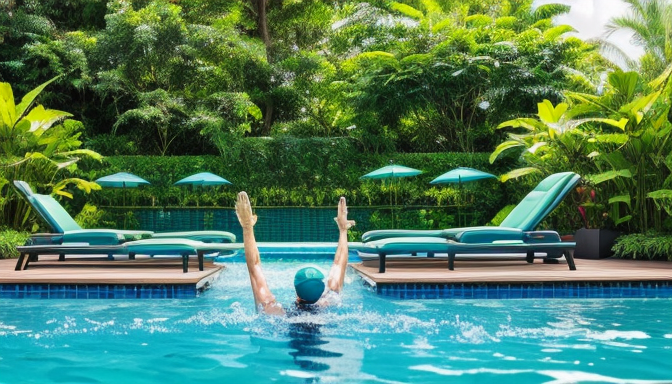This article explores effective techniques to enhance your stroke, focusing on key strategies and methods that can lead to improved performance in swimming and other water sports.
A solid grasp of stroke mechanics is essential for any swimmer. This section delves into the fundamental components that contribute to an efficient stroke, including body position, arm movement, and breathing techniques. The way you hold your body in the water can make a world of difference. Imagine you’re a streamlined torpedo, cutting through the waves with minimal resistance. Maintaining a horizontal position is key; think of your body as a long, sleek arrow. Your arms should move fluidly, mimicking the graceful motions of a bird in flight, while your breathing should be rhythmic and synchronized with your strokes. This harmony between movement and breath is what transforms a good swimmer into a great one.
Incorporating specific drills into your training can significantly enhance your stroke technique. This section highlights various drills designed to target different aspects of your stroke, helping you to achieve better efficiency and speed in the water. For instance, practicing the “catch-up drill” can refine your arm movements, ensuring that each stroke is powerful and precise. Additionally, the “3-3-3 drill” can help improve your breathing patterns while maintaining a steady rhythm. Below is a table summarizing some effective drills:
| Drill Name | Focus Area | Description |
|---|---|---|
| Catch-Up Drill | Arm Movement | Swim with one arm while the other remains extended in front. |
| 3-3-3 Drill | Breathing | Swim three strokes with right arm, three with left, then three full strokes. |
| Single Arm Drill | Technique | Swim using one arm while the other rests by your side. |
By integrating these drills into your routine, you’ll not only build strength but also develop a deeper connection with your stroke. Remember, every stroke counts, and with dedication, you can master freestyle, backstroke, breaststroke, and butterfly with in-depth guides tailored for all skill levels. So, are you ready to dive in and discover the flow?
Understanding Stroke Mechanics
When it comes to swimming, is like having the roadmap to success. Imagine trying to navigate a city without a map; you’d likely end up lost, right? The same goes for swimming! Mastering the fundamentals of each stroke—freestyle, backstroke, breaststroke, and butterfly—can dramatically enhance your performance in the water.
Each stroke has its own unique mechanics, and focusing on the following key components can help you swim more efficiently:
- Body Position: Keeping your body streamlined reduces drag, allowing you to glide through the water effortlessly.
- Arm Movement: The way you pull with your arms can either propel you forward or slow you down. It’s all about technique!
- Breathing Techniques: Knowing when and how to breathe is crucial. A well-timed breath can keep your rhythm intact.
For example, in freestyle, your body should be flat and horizontal, with your head in line with your spine. This position minimizes resistance and maximizes speed. In contrast, the backstroke requires a different body alignment, where your hips should remain high in the water to maintain an efficient stroke. Each stroke has its nuances, and understanding these mechanics will set the foundation for your improvement.
So, are you ready to dive deeper into the world of stroke mechanics? By mastering these elements, you’ll not only enhance your skills but also enjoy swimming like never before!

Drills for Stroke Improvement
To truly enhance your stroke, it’s crucial to incorporate targeted drills into your training regimen. These drills not only help in refining your technique but also boost your overall performance in the water. Whether you’re a novice or a seasoned swimmer, mastering the four main strokes—freestyle, backstroke, breaststroke, and butterfly—is essential. Each stroke has its unique mechanics, and focusing on them can lead to significant improvements.
Let’s break down some effective drills tailored for each stroke:
| Stroke | Drill | Purpose |
|---|---|---|
| Freestyle | Catch-Up Drill | Improves arm extension and timing. |
| Backstroke | Single Arm Drill | Enhances body rotation and balance. |
| Breaststroke | 3-2-1 Drill | Focuses on glide and kick timing. |
| Butterfly | Body Dolphin Drill | Strengthens core and rhythm. |
Incorporating these drills into your routine can feel like adding turbo boosters to your swimming. Imagine gliding through the water with the grace of a dolphin; that’s the kind of efficiency you can achieve. Remember, practice makes perfect, and consistency is key. So, why not challenge yourself and set aside time each week to focus on these drills? You’ll be amazed at how quickly your stroke improves!
Frequently Asked Questions
- What are the key components of an efficient stroke?
To master your stroke, focus on three main components: body position, arm movement, and breathing techniques. Each plays a crucial role in ensuring you glide smoothly through the water, reducing drag and enhancing speed.
- How can drills help improve my stroke technique?
Incorporating targeted drills into your training routine is like fine-tuning an engine. They help isolate specific aspects of your stroke, allowing you to practice and perfect your technique, ultimately leading to better performance and efficiency in the water.
- How often should I practice stroke drills?
Consistency is key! Aim to integrate stroke drills into your practice sessions at least two to three times a week. This regularity will help reinforce good habits and lead to noticeable improvements over time.
- Can breathing techniques really make a difference?
Absolutely! Proper breathing techniques can enhance your stroke by ensuring you maintain a steady rhythm and avoid fatigue. Think of it as the fuel that keeps your engine running smoothly!